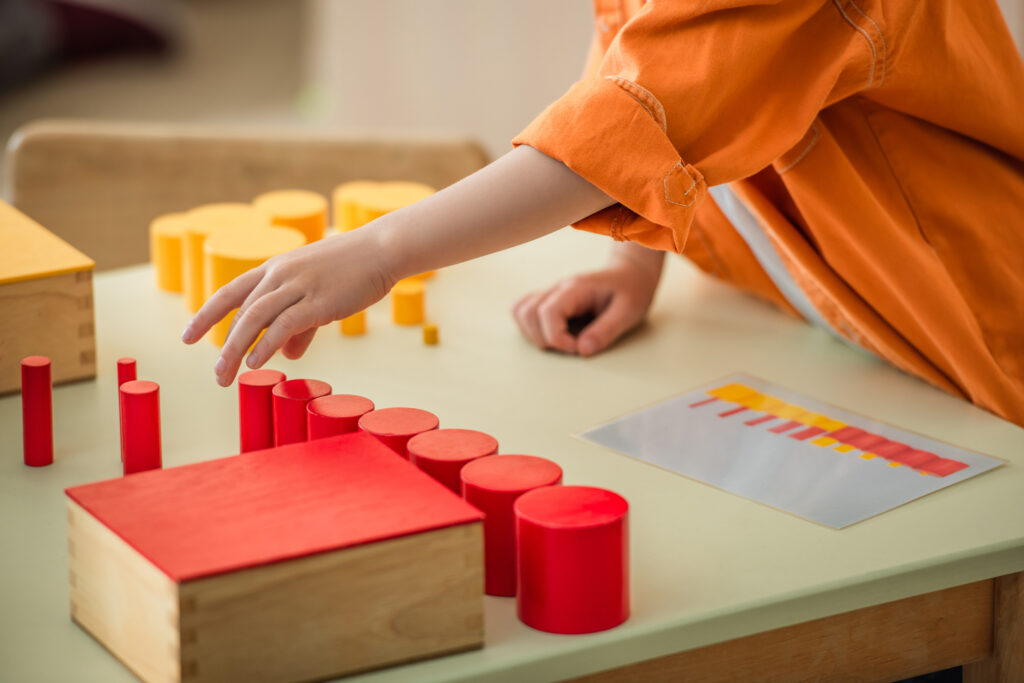Montessori sensorial activities are some of the most engaging for young children, as the elements introduced are always new and exciting. The Montessori Knobless Cylinders are a great example of this – colored cylinder blocks that challenge and excite.
In this article, you will learn what the Montessori Knobless Cylinder material is comprised of, what its purpose is, and how to present it to a child.
You will also get extension activity ideas to help your child make the most out of this colorful Montessori sensorial material.

(This post contains affiliate links. Purchasing from these links costs you nothing extra, but helps with our website upkeep.)
What are the Knobless Cylinders in Montessori?
The Montessori Knobless Cylinders is a material that consists of 4 boxes of 10 colored cylinders. Each box has a lid that matches the color of the cylinders contained inside.
The purpose of the material is to help refine a child's visual discrimination, specifically that of diameter and height.
Each set of cylinders varies methodically in one or two dimensions; height and/or diameter.
- Red Cylinders – each cylinder decreases in diameter, height stays constant
- Yellow Cylinders – each cylinder decreases in both diameter and height
- Green Cylinders – each cylinder decreases in diameter and increases in height
- Blue Cylinders – each cylinder decreases in height, diameter stays constant
Through work with the Knobless Cylinders, children are also introduced to the following grading language:
- short, shorter, shortest
- tall, taller, tallest
- thin, thinner, thinnest
- thick, thick, thickest
This material is introduced in a child's first year of a Montessori primary program, typically toward the middle of the year, after the child has worked with the Knobbed Cylinders – a material with a somewhat similar concept, but a tighter control of error.
- 4 sets of 10 cylinders varying in height and/or diameter in each…
- Each set is in a separate wood box with the lid painted the same…
Aims of the Montessori Knobless Cylinders
- development of visual discrimination
Indirect aims
- fine motor refinement
- introduction of height and diameter
Control of error
- visual
Points of interest
- the color of the cylinders
- the difference in size of each cylinder
How to present the Montessori Knobless Cylinders
Note: The Knobless Cylinders are introduced in the following order: red, yellow, green, blue
- Invite the child to carry the box of red Knobless Cylinders carefully to the table.
- After taking the lid off the box, place the box on top of its lid and put it toward the upper left corner of the workspace.
- Using your thumb and two primary fingers, slowly remove each knob and place them randomly in a row in front of the child.
- Say to the child, “I am going to put these cylinders in order.”
- Pick up the thickest red cylinder and run it slowly along the row of cylinders to compare its size, then place it to the child's left side.
- Select the next thickest cylinder and do the same.
- Continue on in this fashion until all the Knobless Cylinders are in order from thickest to thinnest.
- Touch the top of each cylinder in your ordered row from left to right.
- Again place the cylinders randomly in a row and invite the child to put them in order.
- When it's time to end the activity, tell the child that the cylinder should be put back in the box, thickest cylinder first.
Knobless Cylinder activity extensions
Stereognostic activities
- Place a set of knobless cylinders in a cloth bag and invite the child to order feel for each one to order them.
- Invite the child to perform the knobless cylinders activity blindfolded.
Building Towers
- Have the child build a graded tower with the cylinders.
Matching different sets of Knobless Cylinders
- Set out the red, green, and yellow boxes of cylinders and invite the child to stack cylinders with the same diameter.
Combining the Knobless and Knobbed Cylinders
- Have the child set the Knobless Cylinders in a row on the table in front of the Cylinder Block of the same dimensions. Show them how the Knobbed Cylinders set flush on top of them.
Grading cylinders of multiple sets
- With all the sets on the table, have the child grade each set one by one and in rows
The Montessori Knobless Cylinders are a colorful and fun material for children to work with.
Extension activities with this material are truly only limited by your imagination. They can be sorted, stacked, built into “snakes”, matched to cards, etc.
You will find that children enjoy open-ended building activities with the cylinders, as well as creating challenges for each other when they are working in groups.
Cheers and don't forget to subscribe!
Frequently asked questions
The Montessori Knobless Cylinders is a material that consists of 4 boxes of 10 colored cylinders. Each box has a lid that matches the color of the cylinders contained inside.
The purpose of the material is to help refine a child's visual discrimination, specifically that of diameter and height.
The red Knobless Cylinders are introduced to children first, followed by yellow, then green, and finally blue. Eventually, the sets will be matched, paired, and graded together in a variety of activities.
Show the child how to order the Knobbed Cylinders by size from left to right. Do this slowly and methodically, taking care to let the child see what you are doing.
After you have graded the given set of cylinders, invite the child to try.

